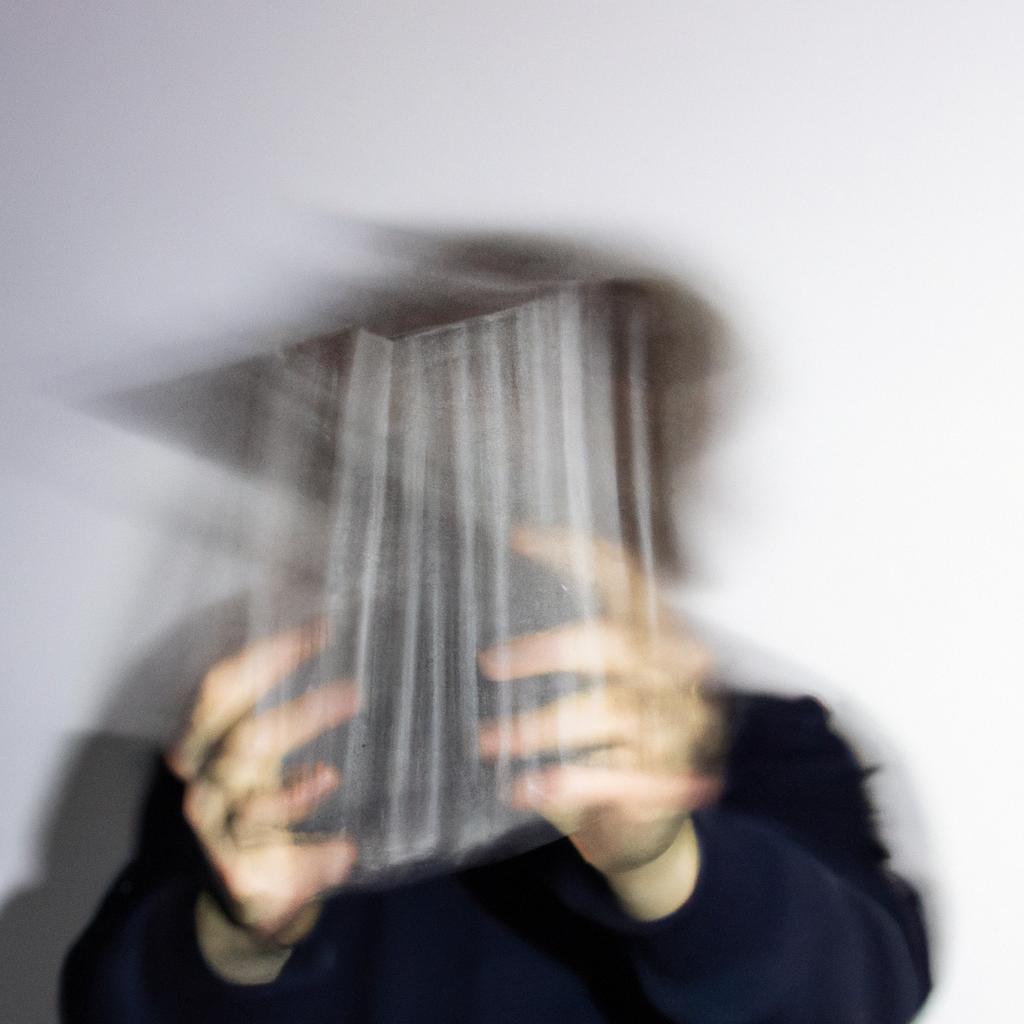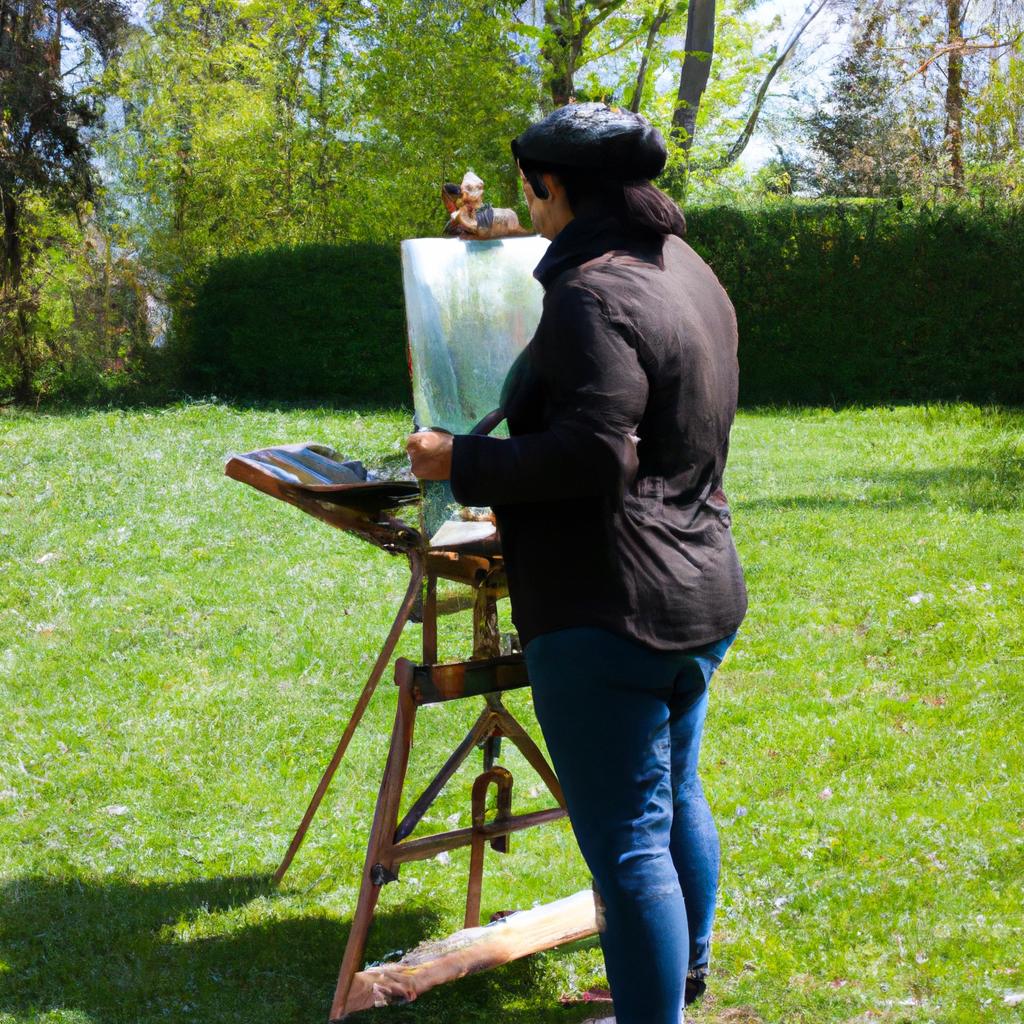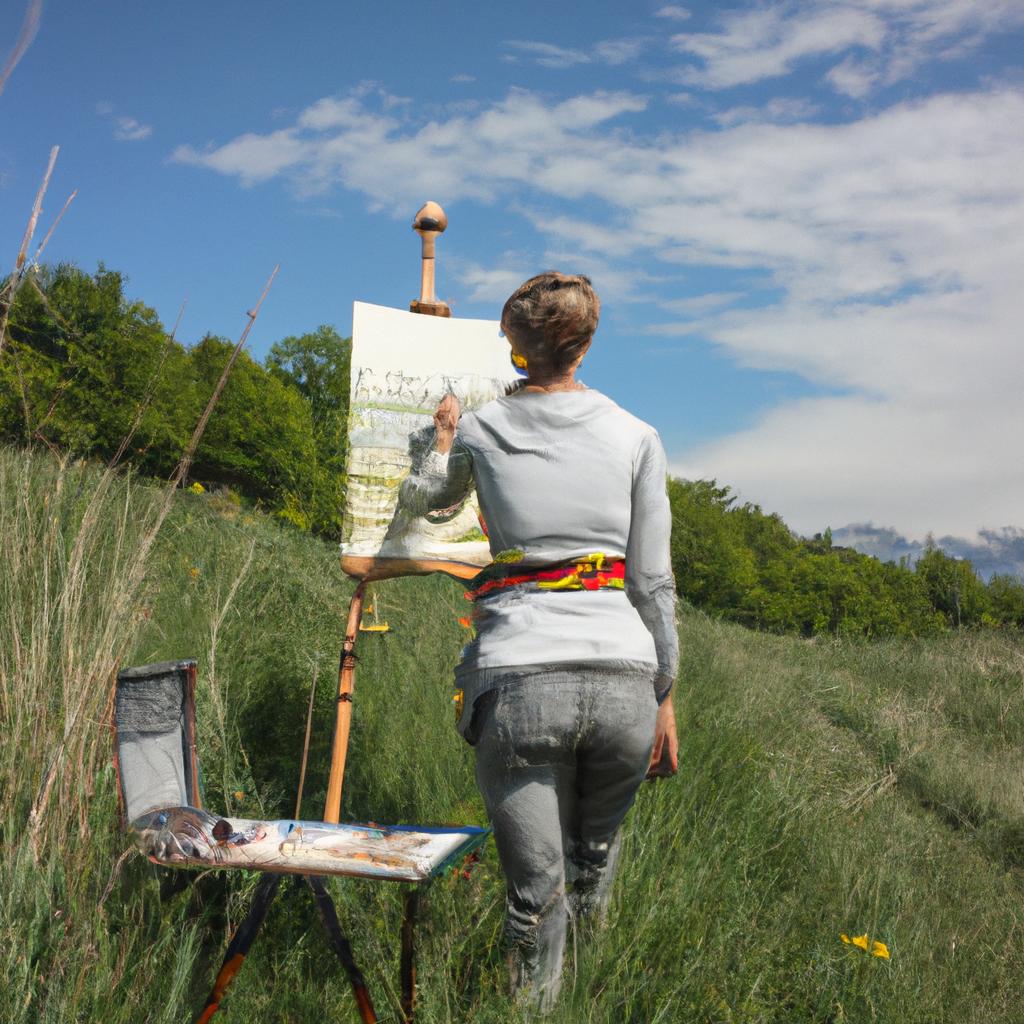The art of portrait painting has long been admired for its ability to capture the essence and personality of an individual. In recent years, however, there has been a growing trend in the world of cinema that incorporates this traditional form of art into the realm of movies. This intersection between arts and movies offers a unique opportunity for filmmakers to add depth and complexity to their characters through visual storytelling.
One notable example of this can be seen in the film “The Girl with a Pearl Earring,” directed by Peter Webber. Set in 17th century Holland, the story revolves around Griet, a young woman who becomes the subject of one of Johannes Vermeer’s most famous paintings. Through Vermeer’s meticulous process of capturing her likeness on canvas, Griet’s character is brought to life in a way that transcends mere dialogue or action. The subtle nuances captured in her expression and posture provide insight into her inner thoughts and emotions, creating a multi-dimensional portrayal that enhances the overall narrative.
By merging the worlds of fine art and filmmaking, portrait paintings offer filmmakers a powerful tool for character development and storytelling. This article will explore how this integration has evolved over time and examine various techniques used by directors to incorporate portraits within their films. Additionally, it will discuss the impact of these artistic choices on audience engagement and interpretation of the characters and storylines.
One technique commonly used by directors is to recreate famous portraits within the film itself. This can be seen in movies like “The Portrait of a Lady” directed by Jane Campion, where specific scenes are composed to mimic well-known paintings. By doing so, the filmmakers not only pay homage to the original artwork but also establish visual connections between the characters and the historical context in which they exist.
Another approach is to use portrait paintings as visual metaphors or symbols that represent certain traits or emotions associated with a character. For example, in the film “Portrait of Jennie” directed by William Dieterle, a portrait painting becomes a central element in the narrative, acting as a catalyst for supernatural events and symbolizing the protagonist’s longing for love and self-discovery.
In addition to incorporating portraits within the film’s imagery, directors often utilize techniques such as framing, lighting, and composition to create cinematic portraits of their characters. Through careful consideration of these elements, filmmakers can evoke certain moods or emphasize specific aspects of a character’s personality. For instance, low-key lighting and close-up shots may be employed to highlight an intense gaze or reveal hidden emotions.
The integration of portrait paintings into films allows for a deeper exploration of characters’ inner worlds and adds layers of meaning to their stories. It provides viewers with an opportunity to engage with the characters on a more intimate level, beyond what dialogue or action alone can convey.
Moreover, this merging of art forms invites audiences to reflect on broader themes such as identity, beauty standards, and societal norms that are often intertwined with portraiture. The juxtaposition between traditional art forms and modern storytelling mediums prompts discussions about the enduring relevance and power of visual representation in our contemporary culture.
In conclusion, the integration of portrait paintings into movies offers filmmakers a unique avenue for character development and storytelling. By drawing inspiration from historical artworks or creating their own cinematic portraits, directors can enhance the depth and complexity of their characters, while also inviting audiences to engage with broader themes and ideas. This intersection between arts and movies opens up new creative possibilities and enriches the cinematic experience for viewers.
The Evolution of Portraits in Film
The Evolution of Portraits in Film
Imagine a classic Hollywood film where the camera pans across an elegantly painted portrait, capturing the beauty and essence of the subject. This powerful visual technique has been used for decades to convey emotion, reveal character depth, and create a sense of timelessness on screen. From black-and-white classics like “Gone with the Wind” to modern masterpieces such as “The Grand Budapest Hotel,” portraits have played a significant role in enhancing cinematic storytelling.
- Aspects that contribute to the impact of portraits in film include:
- Lighting: The strategic use of lighting can accentuate facial features or add dramatic effect, evoking different emotions from viewers.
- Composition: The arrangement of elements within a frame can enhance the overall aesthetic appeal and symbolism of a scene.
- Color palette: Specific color choices can evoke certain moods or highlight themes within a movie.
- Attention to detail: Capturing fine details in a portrait adds authenticity and realism to the characters portrayed.
In examining the evolution of portraits in film, it becomes apparent how this artistic element has become increasingly sophisticated over time. To illustrate this point, let us consider two films from different eras. In Alfred Hitchcock’s iconic thriller “Vertigo” (1958), we witness Scottie Ferguson’s fascination with Madeline Elster through his obsession with her portrait. The composition is carefully crafted; Madeline stares out at us while surrounded by muted colors, emphasizing her ethereal presence amid Scottie’s growing fixation. Contrastingly, Damien Chazelle’s musical masterpiece “La La Land” (2016) incorporates vibrant colors and dynamic compositions during its dreamlike scenes which pay homage to classical Hollywood filmmaking.
This progression highlights not only advancements in technology but also shifts in storytelling techniques throughout cinema history. Directors now have greater control over every aspect of their films’ aesthetics, enabling them to utilize portraits as more than mere set decorations. Portraits have become a visual language, capable of conveying complex emotions and enriching the narrative.
Moving forward, we will explore how famous movie scenes have been inspired by renowned portraits, showcasing the lasting impact of these artistic intersections in film history. From recreating iconic poses to incorporating similar lighting techniques, filmmakers continue to pay homage to the timeless art form that is portraiture on screen.
Famous Movie Scenes Inspired by Famous Portraits
Exploring the Emotional Depth: Portraits in Film
The usage of portraits in film has evolved over time, with filmmakers exploring different ways to incorporate this artistic form into their storytelling. One notable example is the 1997 film “Titanic,” directed by James Cameron. In a pivotal scene, Rose (played by Kate Winslet) poses for a portrait wearing only the Heart of the Ocean necklace, capturing both her vulnerability and defiance against societal norms.
To understand the impact of portraits in films further, it is essential to recognize how they evoke emotional responses from viewers. Here are some key aspects that contribute to this emotional depth:
- Symbolism: Portraits often serve as symbols within cinematic narratives, representing themes such as love, power dynamics, or personal identity. Through visual cues and composition choices, filmmakers strategically utilize these symbolic representations to enhance the overall narrative experience.
- Character Development: Portraits offer an opportunity to delve deeper into a character’s psyche by visually capturing their emotions and inner conflicts. Whether through close-ups or carefully framed shots, filmmakers can convey nuanced details about a character’s personality and motivations.
- Timelessness: Just like traditional paintings, well-crafted portrait scenes have the ability to transcend temporal boundaries. By freezing a moment on screen, filmmakers create lasting impressions that resonate with audiences long after the movie ends.
- Intimacy: The intimate act of painting or being painted adds another layer of connection between characters in films. This process can symbolize trust or vulnerability while inviting viewers into private moments shared between protagonists.
| Symbolism | Character Development | Timelessness | Intimacy |
|---|---|---|---|
| Love | Psychological exploration | Enduring significance | Trust |
| Power dynamics | Motivations | Lasting impression | Vulnerability |
| Personal identity | Personality | Emotional resonance | Private moments |
Incorporating portraits into films not only adds visual interest but also enhances the emotional impact of storytelling. By utilizing symbolism, character development, timelessness, and intimacy, filmmakers create a profound connection between their audiences and the narratives depicted on screen.
Transitioning to the subsequent section about “The Influence of Portraiture on Cinematic Aesthetics,” it is evident that portraits in film have influenced various aspects of cinematic artistry. From lighting techniques to composition choices, these influences will be explored further in the following section.
The Influence of Portraiture on Cinematic Aesthetics
Building upon the connection between famous movie scenes and famous portraits, it becomes evident that portraiture has significantly influenced cinematic aesthetics. Through various visual techniques and artistic choices, filmmakers have drawn inspiration from the world of portrait painting to enhance their storytelling. One intriguing example that highlights this influence is the use of chiaroscuro lighting in film, which creates distinct contrasts between light and dark.
Consider a hypothetical scenario where a filmmaker aims to capture the essence of Rembrandt’s “The Night Watch” in a dramatic scene set during sunset. By employing chiaroscuro lighting techniques, with vivid shadows juxtaposed against illuminated figures, the filmmaker can recreate the dynamic interplay of light and darkness found within Rembrandt’s masterpiece. This not only adds depth and intensity to the visuals but also evokes an emotional response from viewers, immersing them in the narrative.
To further emphasize how portraiture has shaped cinematic aesthetics, we can explore four key elements that often intertwine both art forms:
- Composition: Filmmakers often borrow composition techniques used in portrait paintings to frame their shots effectively. This includes utilizing principles such as leading lines or rule of thirds to create visually compelling images.
- Color Palette: Just like artists carefully select color schemes for their portraits, filmmakers employ specific palettes to evoke certain moods or themes within their movies. These deliberate choices contribute to enhancing characterization and setting.
- Costume Design: Portraits offer glimpses into historical fashion trends and societal norms. Similarly, costume designers draw inspiration from these representations when creating outfits for characters in period films or even contemporary pieces inspired by iconic portraits.
- Expression and Gesture: Facial expressions and body language are powerful tools in both portraits and cinema. Directors often encourage actors to adopt poses reminiscent of well-known portraits to convey emotions more effectively or establish connections between characters across different time periods.
By incorporating these elements, filmmakers create a visual language that resonates with audiences on a subconscious level. The influence of portraiture enriches cinematic aesthetics, offering viewers a more immersive and visually captivating experience.
Transitioning into the subsequent section exploring the symbolism of portraits in movies, we delve deeper into how this art form goes beyond mere aesthetics to convey meaning and metaphor within cinematic narratives.
Exploring the Symbolism of Portraits in Movies
Building upon the influence of portraiture in cinema, it is important to explore how portraits are used symbolically in movies. One example that highlights this intersection between art and film is the 2006 movie “The Girl with a Pearl Earring,” directed by Peter Webber. The film portrays the fictionalized relationship between Dutch painter Johannes Vermeer and his model, Griet. Through the use of portraiture as a recurring motif, the film not only captures the essence of Vermeer’s artistic process but also adds depth to the narrative.
To further understand how portraits enhance cinematic storytelling, several key aspects can be examined:
-
Visual Storytelling: Portraits in movies serve as visual cues that provide insights into characters’ personalities or their relationships with others. For instance, a close-up shot of a character gazing at their own portrait may suggest introspection or self-reflection.
-
Symbolic Imagery: Portraits often carry symbolic meaning within films. They can represent power dynamics, inner conflicts, or even foreshadow events to come. By incorporating such symbolism, filmmakers evoke emotional responses from audiences and deepen their engagement with the story.
-
Historical Context: In period dramas or biographical films, portraits play an essential role in recreating historical settings. Accurate depictions of notable figures through portraiture help transport viewers to specific time periods and add authenticity to the overall aesthetic presentation.
-
Narrative Devices: Portraits can function as narrative devices that drive plot progression or reveal hidden truths about characters. For example, discovering a concealed portrait might unveil a long-held secret or expose deeper motivations behind a character’s actions.
By utilizing these techniques effectively, filmmakers can harness the power of portraiture to elevate their storytelling and create memorable cinematic experiences for audiences.
Moving forward, we will now delve into another significant aspect related to portraits in movies: their role in character development. Understanding how portraits shape and define characters allows us to explore the broader impact of this artistic theme on cinematic narratives.
The Role of Portraits in Character Development
In movies, portraits are often used as a powerful visual tool to convey symbolism and enhance storytelling. These artistic representations provide insights into characters’ personalities, motivations, and relationships. One such example can be seen in the critically acclaimed film “The Portrait of Dorian Gray,” where a portrait serves as a metaphor for the protagonist’s moral decay.
Portraits in movies can evoke various emotions and contribute to the overall narrative through their symbolic significance. To further understand their role, let us explore some key aspects:
-
Visual Representation: Portraits capture moments frozen in time, allowing viewers to connect with characters on a deeper level. They offer glimpses into the past or reveal hidden truths about individuals that may not be immediately apparent.
-
Character Development: By incorporating portraits into films, directors invite audiences to delve into the psyche of characters. The artwork could reflect their internal struggles, desires, or even serve as an external manifestation of their alter ego.
-
Foreshadowing and Symbolism: Through carefully chosen details within these painted images, filmmakers hint at future events or foreshadow character arcs. By analyzing elements such as lighting, composition, or facial expressions portrayed in portraits, astute viewers can anticipate plot developments.
-
Establishing Atmosphere: Portraits also play a crucial role in setting the tone and ambiance of a movie scene or entire film itself. Whether it is an eerie self-portrait hanging ominously on a wall or a grand ancestral painting adorning opulent halls, these visuals contribute to building suspense and immersing audiences into cinematic worlds.
The use of portraits in movies provides filmmakers with a versatile medium for conveying complex ideas and eliciting emotional responses from audiences. In the subsequent section on “The Power of Portraits: Eliciting Emotions in Films,” we will explore how artists strategically utilize this technique to create impactful cinematic experiences beyond mere aesthetics alone.
The Power of Portraits: Eliciting Emotions in Films
Portraits play a significant role in films, as they have the power to evoke strong emotions and create connections between characters and audiences. By capturing the essence of a character through visual representation, portraits can heighten the emotional impact of a scene and contribute to the overall cinematic experience.
One example that demonstrates this power is the film “The Portrait of Dorian Gray.” In this adaptation of Oscar Wilde’s novel, the portrait itself becomes a central element of the narrative. As Dorian Gray’s sins accumulate over time, his portrait ages and shows signs of corruption while he remains eternally youthful. This juxtaposition between the external appearance and internal decay creates a powerful emotional response from viewers, highlighting the consequences of moral deterioration.
To further explore how portraits elicit emotions in films, consider these key factors:
- Visual Aesthetics: Portraits are often meticulously crafted with attention to detail, color palette, and composition. These artistic choices can enhance specific emotions or themes within a film.
- Symbolism: Portraits can serve as symbols that represent aspects of a character’s personality or inner struggles. Their presence on-screen can evoke subconscious associations and trigger emotional responses.
- Narrative Impact: When used strategically within a storyline, portraits can act as catalysts for plot developments or pivotal moments that resonate emotionally with both characters and audience members.
- Audience Projection: Viewers may project their own experiences or feelings onto portrayed characters based on their interpretation of the depicted emotions, intensifying their personal connection to the story.
In addition to these considerations, it is worth examining how different elements work together by using an illustrative table:
| Film Title | Portrait Description | Emotional Response |
|---|---|---|
| “Girl with a Pearl Earring” | An enigmatic portrayal of Vermeer’s maid wearing an exotic pearl earring. | Intrigue, fascination, and curiosity. |
| “American Gothic” | A depiction of a stern-faced farming couple in front of their farmhouse. | Sense of austerity, resilience, or defiance. |
| “Breakfast at Tiffany’s” | An elegant portrait capturing Audrey Hepburn as Holly Golightly. | Glamour, elegance, and allure. |
By incorporating these elements into the visual language of film-making, portraits can elicit a range of emotions from audiences while enriching the storytelling experience.
In summary, portraits possess the power to evoke strong emotional responses in films by visually representing characters’ inner worlds and struggles. Through careful artistic choices and symbolic representations, they contribute to the narrative impact and enhance audience engagement with the story being told. By understanding how portraits can elicit specific emotional responses through visual aesthetics and symbolism, filmmakers can effectively utilize this tool to create compelling cinematic experiences for viewers worldwide.




